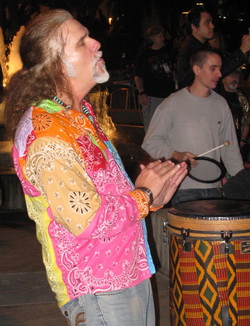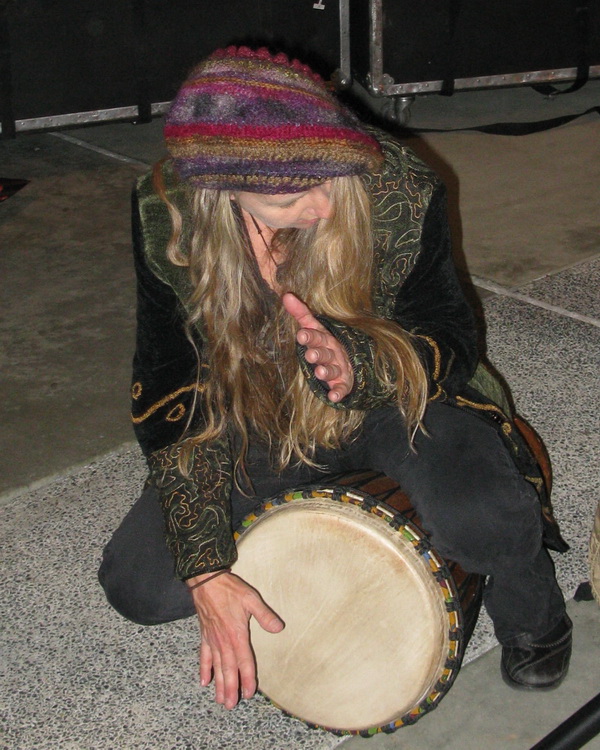| « Students and Music Lovers Welcomed at Summer NAMM | The Words Need Breath, Not Beat » |
Interview with Drum Circle Facilitator Arthur Hull
by Danielle Grigor
This is Part Three in our series on Drum Circles, the people who lead and equip them, and the healing and uniting effects of rhythm in life. (Here is Part One and Part Two.)
Famed drum circle facilitator Arthur Hull took some time from editing his latest book (more on that as it approaches publication) to answer more questions and share some stories of his time in the drum circle movement. Here is a little more background from the man regarded by many as the father of the modern community drum circle movement.
BFMN asked: You have trained thousands of facilitators who have, in turn, led many thousands of people in rhythmic events. Ripples from the stones you tossed have touched every shore. What single message would you most want heard?
AH: The experience of exploring and expressing your rhythmical spirit can serve you as an individual in many ways. While teaching Village Music Circles ™ Facilitator Playshop trainings in 15 countries for over 20 years, I have watched the recreational drumming movement grow and develop. After seeing rhythm based events being embraced and utilized by the many varieties of professional service providers in our society, it is my belief that facilitated drum circles will evolve in such a way that it will become an ordinary part of our everyday lifestyle.
BFMN: What first made you get involved with drum circles and what made you make it so much a part of your life?
AH: The Summer of Love… This is the story of my first conscious act of drum circle facilitation; it set me on the path my life has taken. Now, more than 40 years later, I am still experimenting and learning more about rhythm-event facilitation.
During the Summer of Love in San Francisco in the late 60s, the hippies were hanging out in the Haight-Ashbury district next to Golden Gate Park, where free psychedelic music concerts were being offered by the Grateful Dead, Janis Joplin and Jefferson Airplane. Also, in Golden Gate Park, drummers liked to meet on Hippy Hill. You could go there at almost any time of the day and find a freeform anarchist drum circle.
The ebb and flow of exciting freeform rhythms lured me into the Hippy Hill rhythm web. I was in my late teens, freshly drafted into the military and spending my off-duty weekends at Hippy Hill. It was the drums and not the hippie drug culture that attracted me. I had taken a few Afro-Cuban drumming classes from a teacher in San Francisco who had told me to stay away from those hippie drummers. He said they would spoil my traditional hand drum training. What he did not know was that I had been a freeform rhythm expressionist from the time I could first walk.
In my earlier rhythmical explorations, I had played drum kit with musical groups, and hand drums with three or four drummers at a time. That summer, I became a Hippy Hill regular, drumming for as many as eight hours a day every weekend I could get off the military base. Ten to forty drummers, sharing their rhythmical spirits at the same time in a circle, was a new and exciting experience. My enthusiasm for the freeform drumming experience was tempered only by my frustration with the rhythmical train wreck that would ultimately bring any drum circle groove we created to a screeching, messy halt.
By the end of the Summer of Love, I was also studying with several drum teachers, playing established culturally specific rhythms. I enjoyed this format that defined a preset number of players with specific parts, creating a rhythm groove together; we were able to play together for long periods. But I did not enjoy being confined to playing one specific rhythm pattern without the freedom to add my spirited interpretation.
My attraction to the Hippy Hill circles was the freedom of expression that was encouraged. But I was beginning to recognize that the hippie drummers sometimes lacked an understanding of the universal principles that foster group playing consciousness. Because of this, they could only maintain a strong rhythm groove for short periods. While the culturally specific drummers offered me hours of playing deep, traditional grooves while locked into a specific part, the Hippy Hill drummers offered me short flashes of freeform grace and beauty, interspersed with lots of rhythm noise and train wrecks.
I was then, and I am still now, straddling those two opposite drumming cultures. On one of my last Summer of Love drumming weekends, before I was to be shipped out to a military base overseas, I found myself playing in a powerfully magical rhythm groove. It was only shaky around the edges, because a few drummers were paying more attention to their own rhythm instead of supporting the group’s intention to play together. I could hear and feel the beginnings of a train wreck waiting for us down the rhythm track. I did not want this magic to end, simply because three out of twenty-five players were playing with themselves rather than with the whole group. I was frustrated. I understood that these few unconnected players needed only to lift their heads, look around the circle, and connect with the group pulse. The magic was too good to be rhythmically stepped on, and I wished with all my might that they would wake up and join the magic. This did not happen, though, and the groove slowly became less magical as it headed towards its inevitable demise.
I saw other players in the circle noticing what was happening as we tried to keep the magical groove from turning into a regular thunder-drummer groove-ending train wreck. So I did the unthinkable. I broke the most basic anarchist drum circle rule of etiquette: “No leaders allowed.” After jumping into the middle of the circle and getting the attention of all the players, I marked the pulse by pounding my right fist into my left up-raised palm. The unconnected players became more conscious of the pulse. The shaky rhythm solidified back into a magical rhythm groove and I returned to my seat and played. We continued to enjoy the renewed rhythm for a long time, until it came to its natural conclusion.
Instead of a train wreck, it was as if we all decided at the same time that we were done and mutually brought the groove to completion. After we stopped, I was thanked by some of the players for “saving” the groove. Someone yelled, “Next time use a cow bell.” A ding went off in my head and the next time I did. That was the beginning of my facilitation career.
BFMN: You have traveled the world teaching and leading drum circles. Which experience made the most impact on you and why?
AH: Wherever I go in the world, I try to do a free “Tithing Gig” to give back to the church of rhythm for what it has given me during my life time.
While I was in Singapore, on one of the first of my annual spring Asia training tours, I was asked to visit a group of mentally-challenged children in a “special” school. I said that I would be more than happy to visit the school, but I needed to know how how many kids that they wanted me to work with in order to collect enough enough percussion toys and instruments for them.
Their response was “No, no, Mr Hull. These children are mentally challenged and we don’t expect them to participate. We would like you just to go there and play for them and show them your exuberance and you elfishness.” I said that I would be happy to do that, provided that we also are able to have enough percussion toys available for the children, regardless of whether they were going to use them or not.
On the way to the Yio Chu Kang Garden School in Singapore, my host kept reiterating the fact that I should not be disappointed if the children that they present to me are in different states of mental focus and attention. She said that I might get some kids to participate, but not to be disappointed if I don’t get a fully participating drum circle for any length of time. It was obvious that her expectations of the mentally-challenged children, their attention span, and their ability to participate was not very high.
After we arrived and set up the circle, seating the children with their caretakers standing behind them, I became my best elf self. I played my drum, danced around the middle of the circle, got the kids’ attention and began to engage with them. Because the drum membrane vibrates, and goes directly to the body, bypassing the brain, the children’s bodies responded. We all got excited together. As I jumped around, I put the drum down, picked up other percussion toys and playfully handed them out to the children. Once we got started I would do call and response patterns with the children. We got to the place where we could sing sounds together, clap our hands together and play our instruments together. The caretakers had scheduled a twenty-minute session, thinking that that was the longest extent that the children could spend doing any one particular activity. Except for one small child who got scared of the noise, we stayed together in that room and played together for forty minutes.
On the ride back to the hotel my host apologized for underestimating my abilities to work with the children. I told her that she did not underestimate mine or the children’s abilities, she underestimated the ability of of percussion rhythm to bypass the differently-functioning circuitry in the children’s brains, and connect with the circuitry that is totally functioning in their bodies. It is that particular incident that convinced me that the vibration of a drum, like water seeking the ocean, can flow past any challenged circuitry in a person (whether in that person’s body, emotions, or mind), reaching out and enlivening any circuitry that is still functional with in that person.
That experience at the Yio Chu Kang Garden School in Singapore made a strong impact on me, and its revelation has shown itself to be true in the hundreds of deaf, blind, mentally and physically challenged populations that I have facilitated over the years.
Look for more from BFMN in our continuing series on the many and varied uses and effects of percussion in all aspects of society, including more stories from Arthur Hull and a visit with the good people at the REMO Drum Company.
2 comments
| 5 star: | (1) | |
|---|---|---|
| 4 star: | (0) | |
| 3 star: | (0) | |
| 2 star: | (0) | |
| 1 star: | (0) | |
*****(5.0)
Thank you for a great post on Arthur’s rhythm journey! I appreciate that you gave my good friend the opportunity to tell his wonderful story in such detail.
Arthur is a great example of what people can accomplish when we find, and feed, a passion in our lives!
Positive Rhythms,
Jim
For over 10 years, I follow you from afar Land of Israel,
I invite you to be our guest of honor,
David
From Israel






